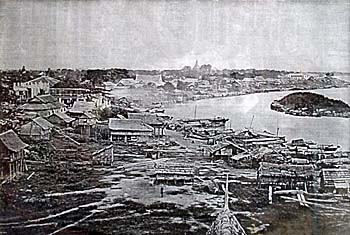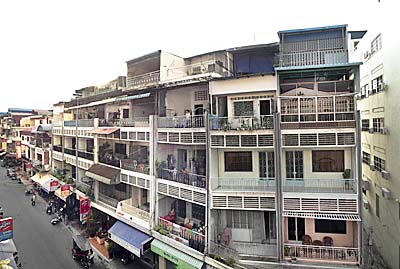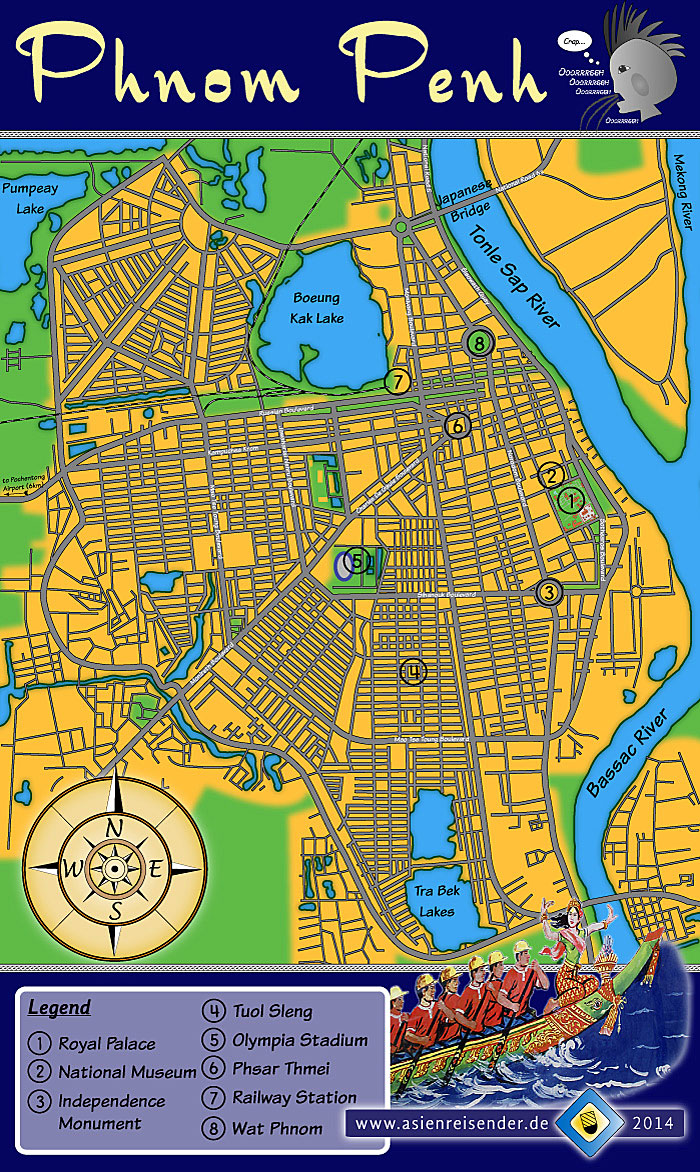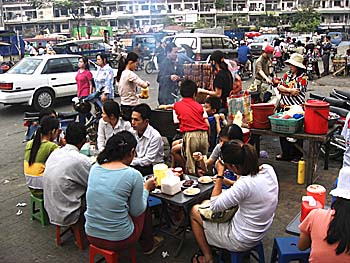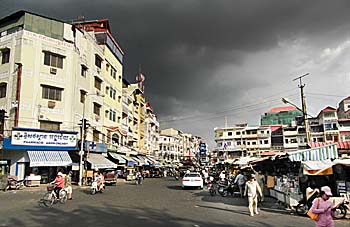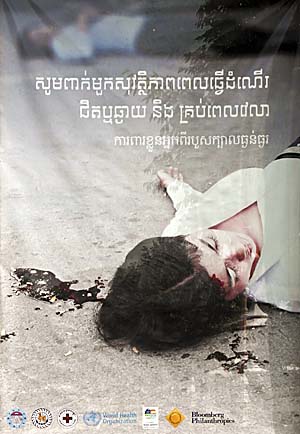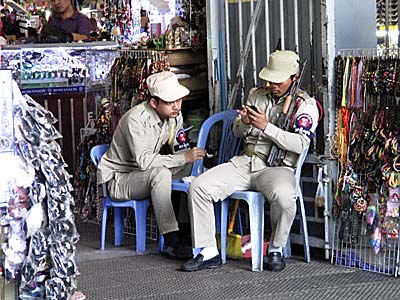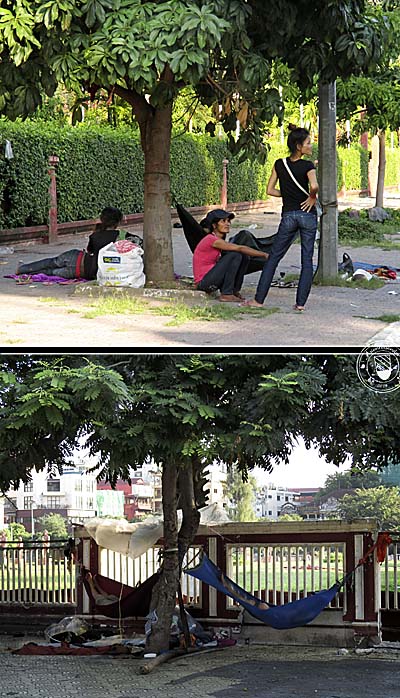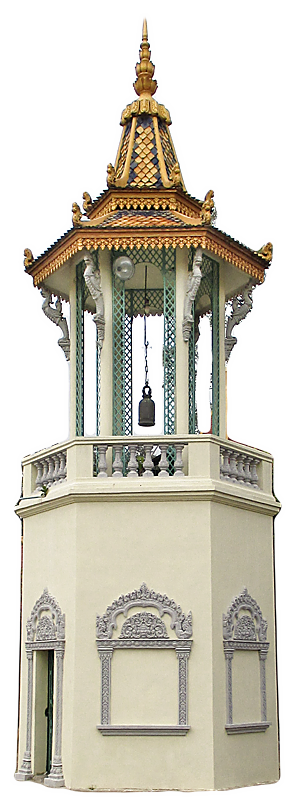3.
The Sights of Phnom Penh
Phnom Penh is the by tourists second most visited place in Cambodia, after Siem Reap/Angkor Wat and the Archaeological Park there. That's barely because of the few, comparably poor sights in the city. It's for the nightlife. The nightlife is notorious - after dusk parts of Phnom Penh turn into a kind of sin city. Sex-tourists, smaller and bigger perverts, criminals, drug-addicts and all kinds of retarded find here their El Dorado.
Wat Phnom
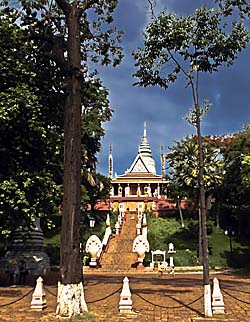
Wat Phnom. This place was namegiving for the city. Image by Asienreisender, 2013
Another reason for tourists to come here is shopping. I don't know what to buy here what one doesn't get elsewhere, but defenitely there is much to buy here. In fact there is everything for sale here, including drugs, arms, people, politicians, companies etc. In the end it's just a question of the price.
For classical tourists and culture freaks the biggest and most representative sight in Phnom Penh is the Royal Palace. It looks spectacular on the first glance. Nevertheless, it's not a really old Khmer building compound, but built by the French in the 19th century for their new vassal kingdom.
Wat Phnom is an old temple on a hill erected in 1372 CE. The hill was the name giver for the later capital.
In the 1950s a couple of buildings were built in a certain mixture between contemporary western and ancient Khmer architecture. Among them was the former national theatre (torn down in 2008) and the royal university, as well as some villas for the upper-class of the time.
There is a remarkable central market (Phsar Thmei), built in art-deco 1920s style. A few years ago it was still a crowded, dirty place; in 2009 it was restored and now it looks clean and proper.
The Royal Palace
Royal Palace Map
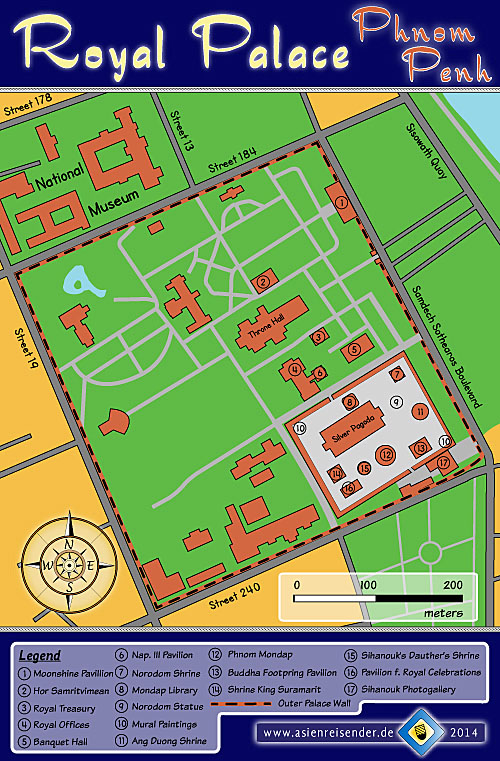
After the downfall of Angkor Thom in 1431 CE the Khmer capital moved to Phnom Penh at the banks of the Tonle Sap / Mekong River. But the place was small, merely a village. Phnom Penh remained the Cambodian capital for a few decades only, then the capital was moved to other places such as Basan, Longvek (Lovek) and then Udong (Oudong). The royal court moved back to Phnom Penh in 1863, the year when Cambodia became a French protectorate.
So, in stark contrast to Cambodia's past temples of Angkor Wat and all the other thousand temple buildings in the Siem Reap region alone, the Royal Palace in Phnom Penh is of a comparable young age. Moreover it's not that much original Cambodian, but built under French supervision with the help of Siamese know-how and architects.
The then king Norodom (reign: 1860 - 1904), eldest son of king Ang Duong, (the one who was met by Henri Mouhot in Kampot 1859), first moved into a temporary wooden palace which was placed a bit north of the nowadays palace's site. Might have been the place where the Cambodian National Museum is situated now. Phnom Penh became officially the new capital of Cambodia in 1866. The Royal Palace here had a versatile history of added and demolished buildings since then. The architectonical style is a mixture of traditional Khmer design, Thai style and European implementations. The Cambodian royal court moved permanently into the new palace in the year 1871. The palace walls were added two years later. At this time Phnom Penh itself was still just a small village with a concise number of wooden houses along the river banks.
Entrance Gate, R. Palace
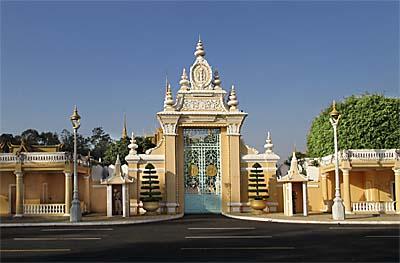
The eastern entrance gate to the Royal Palace, which leads straight to the Throne Hall. It's closed for commoners. Image by Asienreisender, 2014
Following kings as Sisowath (reign: 1904 - 1927), Monivong (reign: 1927 - 1941) and Sihanouk added more buildings and replaced or demolished older ones. Only some buildings date back to the 19th century.
Nowadays the Royal Palace is the main tourist sight in Phnom Penh. Entrance fees enjoyed a markup to 6.50 US$ (that's 25,000 Riel at the time of writing this, what is 12/2014; it was 2 US$ at my first visit in early 2007). Photographing is not allowed in the Silver Pagoda. Most of the palace buildings are not accessable for tourists. The greater part (about two thirds of the palace areal) is completely closed for visitors. It's still in use as a residence for the current king Sihamoni and his court (the inner court or private sector). For a visitor it's highly recommendable to arrive at opening time (8 a.m.). Soon later the place is flushed with package tour tourists, the majority of them footsore, ignorant and many of them appear more dead than alive.
The size of the palace contains an area of 174.870m2 (the side lengths of the outer wall are 402m and 435m). The most significant buildings are the Throne Hall, the Moonlight Pavilion and the Temple of the Emerald Buddha (commonly called the 'Silver Pagoda'). Additionally there are some stupas, an extensive mural painting depicting the Khmer version of the Ramayana epic and the Iron Pavillion of Napoleon III.
Throne Hall
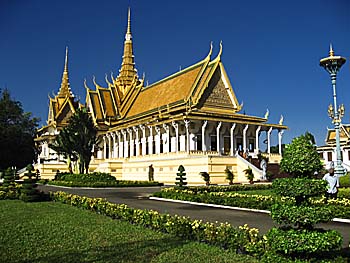
Phnom Penh's Throne Hall, inside the Royal Palace. Image by Asienreisender, 2007
The Throne Hall
One of the first things one sees when doing the tourist trip through the Royal Palace is the Throne Hall. It's a large building with three spires of who the central one is very remarkable because of the four-faced head which it shows. It's 59m high and shows the head of Brahma which looks in all the four directions of the compass. The Throne Hall is still in use for certain purposes as coronations, royal weddings, diplomatic happenings and other events. The inside is closed for tourists. The Throne Hall has been built in 1917, but there was another, wooden Throne Hall at the same place before. Particularly beautiful are the ceiling paintings. The constructors of the building, however, didn't use the whole ceiling for paintings, and that looks a bit strange. The edges are are not painted with pictures as the center is; empty space is left there.
Inside the hall are three thrones and two statues of former Cambodian kings.
Next north to the Throne Hall is the much smaller Hor Samritvimean placed.
The Moonlight Pavilion
Chhan Chaya Pavilion
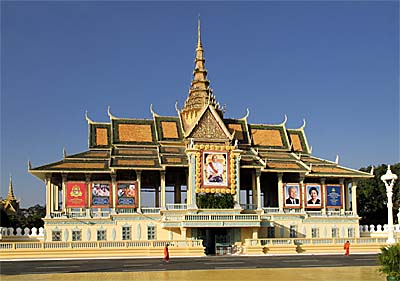
The Moonlight Pavilion, seen from the Suthearos Boulevard outside the palace. Image by Asienreisender, 2014
This representative building is integrated in the palace wall and is also an entrance gate to the palace for the king and other officials. It's very remarkable already when walking outside the palace on the road. Two guards are posted in small housings, and occacionally a group of palace forces parade up and down the boulevard. Some very big posters show the king among his adoring people (very similar to many of this kind in Thailand). The Moonlight or also Chhan Chaya Pavilion has a balcony which can be used for watching official events who happen on the very wide Samdech Sothearos Boulevard in front of it. The boulevard is usually closed for vehicle traffic, but pedestrians are allowed. As well as the Throne Hall, the former, wooden construction of the Moonshine Pavillion has been replaced (in 1914) by the present building.
The Silver Pagoda
Buddha Footprint
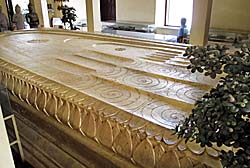
Inside the 'Buddha Footprint Pavilion'. The artefact is several meters long. Image by Asienreisender, 2014
The so called Silver Pagoda is rather a vihear, called 'Wat Preah Keo Morokat' (or 'Temple of the Emerald Buddha'), and it's housing besides a great deal of treasures a precious Buddha statue. However, the emerald Buddha of Cambodia is not, as the emerald Buddha in the Royal Palace in Bangkok, made of real jade. In front of the green Buddha is another, upright standing and tall Buddha statue placed. It's lifting it's hand as it would demand the observer to stop. This Maitreya Buddha is made of 90kg gold and adorned with thousands of diamonds. Additionally a great deal of valuables are piled up here, good for nothing, while a considerable part of the folks is starving beyond the palace walls. Photographing is strictly prohibited, guards are all around. The Silver Pagoda got it's name because the floor was tiled with far more than 5,000 silver tiles, each one of the weight of 1.125kg. Now the floor is covered with carpets and the precious metal is mostly hidden below.
Wat Preah Keo Morokat
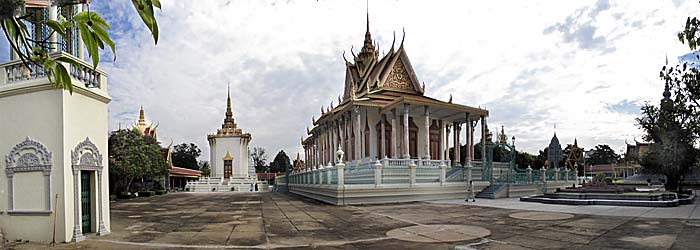
The Silver Pagoda. Left is the bell tower, right is a model of Angkor Wat. Image by Asienreisender, 12/2014
The Silver Pagoda was in a desolate state and had to be rebuilt in the 1960s. That has been done preserving the same style as it was before. The vihear is the official temple of the king of Cambodia.
Khmer Scrolls
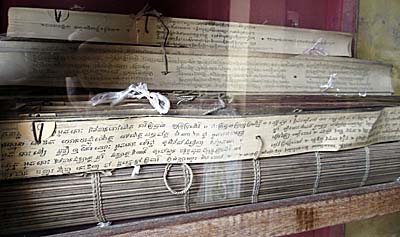
Old scrolls in the Buddha Footpring Pavilion. Seldom to see nowadays. They give a hint to how the ancient Khmer scrolls might have looked in the libraries of Angkor. Image by Asienreisender, 2014
The vihear is surrounded by a number of other constructions of different kinds. There is a small temple stupa with a Buddhist shrine and a Nandi statue inside, what was formerly a library. Nandi is a bull and the vehicle of the Hindu god Shiva. There is a horse memorial with king Norodom I on it and a bell tower. The stupa north of the Norodom memorial is a shrine containing Norodom's ashes. West of the vihear is a small model of Angkor Wat. There are three tall stupas dedicated to deceased members of the royal family and another pavilion with a huge Buddha footprint (Koeng Preah Bat). A number of old scrolls are preserved here in some cabinets. The whole square is surrounded by a wall on which the Reamker (the Khmer version of the Indian Ramayana) story is painted, comparably to the Ramakien paintings in the Royal Palace in Bangkok. The paintings have been made in 1903 and 1904 and are mostly in a poor condition and need urgently restoration. Some restoration has been done, and these parts of the paintings look much better than the rest. Why isn't the restoration continued? The story starts south of the east gate and turns clockwise around.
The Reamker Gallery

The Reamker gallery, part of it along the northern wall. Image by Asienreisender, 12/2014
Napoleon III Pavilion
The Iron Pavilion
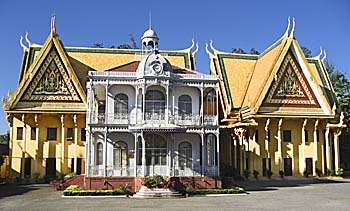
In December 2014 the Iron Pavilion was covered with a tarpolin. This image is made in 2007 by Asienreisender.
In a very contrast to all the other traditionally styled Southeast Asian buildings on the palace grounds stands the Napoleon III Pavilion. Built completely in iron it's style reminds rather to the Eiffeltower in Paris than to anything Asian. The building has an exceptional history itself. It was used for the opening celebration of the Suez Canal (1869) and dedicated to Eugenie of France, empress and wife of Napoleon III. It's stated that 'emperor' Napoleon III made it a present for king Norodom of Cambodia in 1876. In fact, Napoleon III wasn't emperor in 1876 anymore, for he lost this very title together with the Franco-Prussian war of 1870/71. Inside there is usually a small museum, but was found closed in December 2014.
National Museum of Cambodia
Garuda
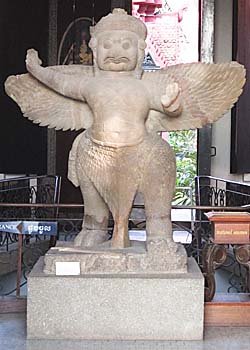
A garuda in the entrance area of the National Museum. It's an extraordinarily large one, in a dynamic position and in a pretty good shape. Image by Asienreisender, 2014
Cambodia is clearly the country with the longest history in Southeast Asia. The first civilization in the world region, Funan, rose up in the Mekong Delta long before the arrival of the Vietnamese. Cambodia is also the country with the largest cultural contributions to the world region, particularly in the years of the medieval empire of Angkor. However, those civilizations who appeared early as grand ones in history, once they lost their power their time is over forever. The Egyptians, the Greec, the Romans had their great times long ago and set standards, but after their decline other civilizations replaced their role, and in the present world these countries are of little influence. Cambodia nowadays is a meaningless country without much living culture. It's grand times date back to the centuries before 1500 CE. Since then it came under the strong domination of other powers, the Siamese above all, and the Vietnamese, later the French. Much of the cultural treasury of the 'glorious' past has been destroyed or stolen. Not only by foreign conquerors but also by Cambodians themselves. The Khmer Rouge were very eager to sell out what they could to gain weapons and ammunition in return. They demolished the museum and abandoned it. A considerable part of the Cambodian cultural treasury might be to find in France now. Saying that is not to blame French archaeologists; they were the first who systematically explored the country's history and did a lot of restoration work on the old monuments, namely in the heart of the Angkor territory around Seam Reap. Tomb raiders from many different nations were attracted after the world got knowledge of the ancient Angkorian civilization, and many local tomb raiders took what they could before. In their view it wasn't even theft - the artefacts and valuables were just there, abandoned in the jungle, and nobody cared. However, art theft is ongoing and many important pieces are sold on black markets and come into the hands of private collectors. So it comes that what is left for the public now is just a small fraction of what there was in the past. It's so little that it is often difficult or impossible to imagine how it once was.
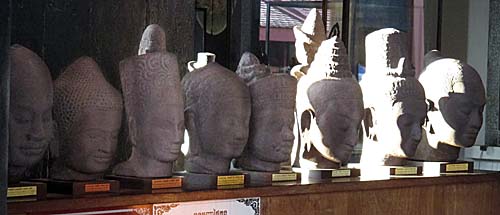
A number of heads at the ticket desk of the National Museum. They represent different styles and most of them where, presumably, the heads of complete sculptures. Image by Asienreisender, 2014
For those who are interested in Khmer and Southeast Asian history and culture, the National Museum of Cambodia is home for the richest collection of Khmer art accessable for the public.
Before the Europeans established colonies in Southeast Asia, the local people didn't have much knowledge about their history. Most of it was legend. Angkor Wat, for example, was widely believed to have been built by a species of giants or gods who later disappeared. A modern approach to history, based on scientific method, was only introduced by European scientists and explorers like Adolf Bastian, just to name one. So it was no wonder that the National Museum was also built by the French colonialists who started to restore the Angkorian temples and ned a safe place for the many artefacts they found. The Museum's architectonical style itself is a successfull blend of classical Khmer architecture in combination with younger Buddhist temple innovations. The construction time covered the seven years from 1917 - 1924.
National Museum, Phnom Penh
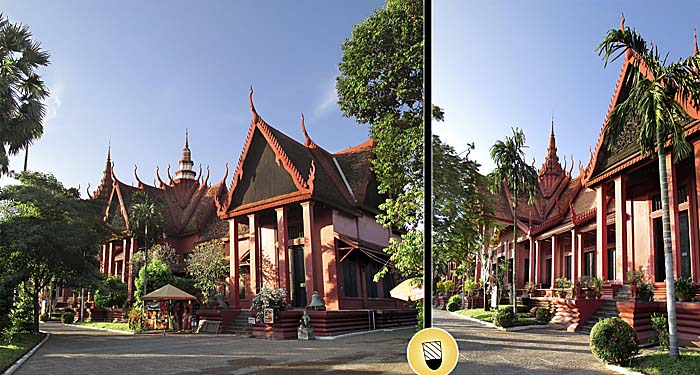
The National Museum from outside. The basic architecture is clearly echoing the classical Angkorian Khmer style, while the spires and the roofs are rather a contribution to later buddhist temple style. Images and photocomposition by Asienreisender, 12/2014
The museum's collection consists of more than 14,000 pieces, who's age covers the timespan from prehistory via the early empires of Funan and Chenla, the classical Angkorian era and the post-Angkorian age. The National Museum of Cambodia is situated directly north of the Royal Palace. Behind the museum there are some workshops and a stage for performances. The entrance fee is 500 Riel for Cambodians as the Khmer Rich; foreigners pay 40 times the price, that's 5 US$ at the time of writing this. Photographing is forbidden in the museum galleries.
Phsar Thmei

The central market Phsar Thmei, Art Deco style. Built in 1937 by the French colonial regime, it's one of the most remarkable buildings in the city and in it's architecture a unique market in whole Southeast Asia. The building is also a landmark in the Cambodian capital and approximately located in the geographical center of it. Until 1975 Phsar Thmei was the trade center of Phnom Penh. In the years 2009 - 2011 renovated with financial aid from a French institution, it is presenting itself in a distinguished clean and ordered manner. The large building has four wings and a central dome of a huge size. Surrounded by foodstalls who offer food of better quality and a greater variety than at other places, the inner part houses a number of shops who sell jewellery, clocks, clothes, electronics and so on. There must be over 3,000 shops in total in Phsar Thmei nowadays. The cleanliness and tidyness of the market gives a stark contrast to the other markets in the capital. It's also much less overcrowded than most of the city. Therefore it has the recommendation to be pricier than elsewhere.
P. Thmei, Central Dome
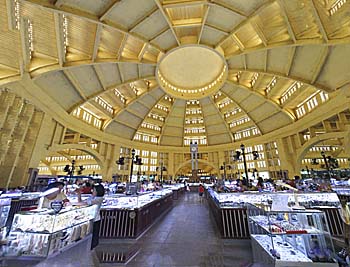
The central dome from below. It's 26m high with a diameter of 45m. The four outer wings have a length of 44m. The wings are put on pillars, and the construction has numerous openings who give the building a pleasant microclimate.
Image by Asienreisender, 12/2014
The former landscape here was a lake, swelling in rainy season and shrinking in dry season. For the construction of the building the lake had to be drained and filled. Periodically problems with overflooding appeared at the place. However, the drainage of the site was a key for Phnom Penh's expansion to the west, a landscape what was formerly coined by rice paddies.
In the Franco-Thai War in 1942 the market was bombed by the Thai Airforce and heavily damaged. Under the rule of the Khmer Rouge (1975 - 1979) Phsar Thmei was used as a horse stable.
The renovation in the years 2009 - 2011 was comprehensively and included a new drainage system (the groundwater level is merely 15cm below the surface), road extension around the market, more parking space for the ugly tin explosion, new electricity poles and electronics, and expanded roofs between the wings for the establishment of more market stalls. The French 'Agence Francaice de Developpement' (AFD) gave 4.5 million Euros in support for the project. The original outfit of the historical building has been mostly retained.
Some Cambodians believe in the existence of a guardian spirit being around here. The spirit's name is Lok Ta Psar Thmei. In the past, before the Khmer Rouge regime, the Chinese community celebrated an annual lion dance at the place to honour the spirit Lok Ta, and the buddhist community pays also great respect to the ghost. Particularly at nighttime, it's said, the spirit is wandering around in the building.
Image by Asienreisender, 2013
The independence memorial is said to represent the new Khmer architecture, although it's built as a remake of a traditional Angkorian temple tower. A huge Olympic Stadion is also considered among the new architecture. It's used by the national football team and for some big sports events. Olympic games never happened in Phnom Penh.
Olympic Stadium

Phnom Penh's Olympic Stadium, designed by prince Sihanouk's star architect Vann Molyvann. Over the day it's empty, in the evenings it fills with crowd doing exercises.
The Olympic Stadium was inaugurated in 1964 and meaned to be the site for the Asian Games. In the following years the stadium with a capacity for 60,000 visitors was a landmark for Phnom Penh's modernization. Privatized in the year 2000 it's now neglected and in a state of disrepair.
Image by Asienreisender, 2007
The banks of the Tonle Sap River at the confluence with the Mekong River are paralleled by a 3km long and broad promenade (Sisowath Quay). That's among the very few places in Phnom Penh where one can walk widely undisturbed by traffic. The promenade is paralleled by a busy road. On the other side of the road are blocks with countless restaurants, bars, hotels and guesthouses. It's the touristic center of the city.
Cambodia's National Assembly
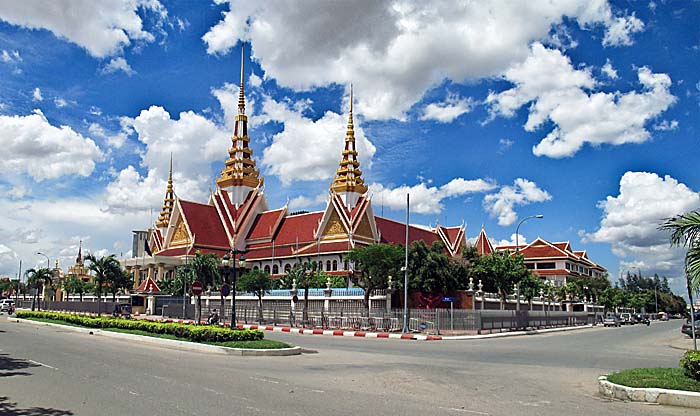
Cambodia has a two chamber parlamentary system, of which the national assembly is the lower house; the second chamber is the senate as the upper house. The assembly itself is, in theory, consisting of 123 elected members. An absolute majority of a party or coalition, to form the government, must occupy then at least 62 seats in the parliament. The current national assembly was the result of the September 2013 elections, the fifths elections since the UNTAC (United Nations Transitional Authority in Cambodia) intervention in 1992/93. In the first year it was boykotted by the largest oppositional party, the Cambodian National Rescue Party, due to massive election fraud.
Image by Asienreisender, 8/2015
Phnom Penh's Central Post Office
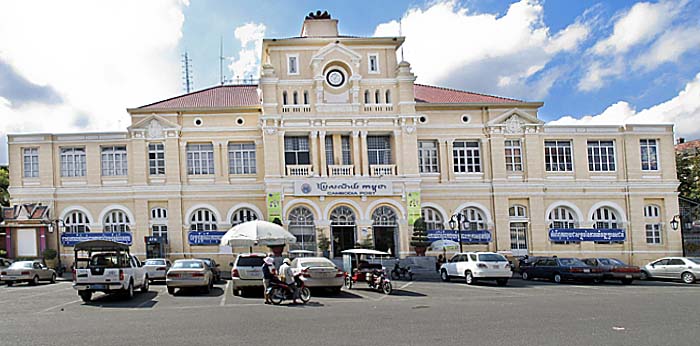
The main post office. An old colonial building, which got restorated and reopened in 2004. It's always an adventure to send post in Cambodia. First, the staff is reluctant to serve a customer at all, second the postage is somewhat magic. Image by Asienreisender, 2014
Tuol Sleng, or: S-21
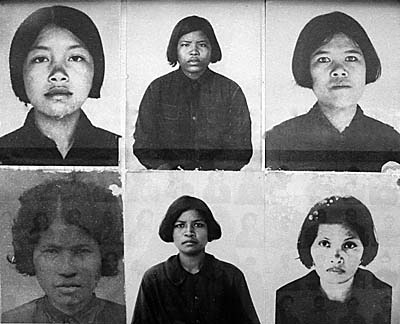
Six of around 17,000 prisoners in Tuol Sleng, photographed at their arrival. They all were doomed to die. Image by Asienreisender, 2007
When the Khmer Rouge gained control over Phnom Penh on April 17th, 1975, they widely evacuated the city of it's inhabitants and the masses of refugees who gathered at the time in the city. Soon later they ruled over whole Cambodia. Their rule was exclusively destructive. A central part of their agenda was a furious revenge. Therefore about 150 torture centers were equipped in the country. S-21 (Security Prison 21), also called Tuol Sleng (Khmer for 'Poisonous Hill'), was one of them, placed into a secondary school (with the former name 'Chao Ponhea Yat High School' or 'Tuol Svay Prey') in the then outskirts of Phnom Penh.
Tuol Sleng served allegedly as an interrogation center. For gaining valuable information it must have been ineffective, because the 'interrogated' prisoners were tortured and had to confess anything what they invented or what the torturers wanted to hear. Numerous other people were blamed under torture, family members, friends, acquaintances of the victims. The interrogation was insofar merely a legitimation for another, the real purpose: to torture and to kill. As Alexander Hinton elaborates in his work 'Cambodia in the Shadow of Genocide', the Khmer concept of revenge is not 'an eye for an eye', but 'a head for an eye'. Means unproportional revenge. As many other unappetizing customs it's, according to Hinton, a deep factor in Khmer culture, which also often appears in all-day-conflicts.
Tuol Sleng, inside and outside
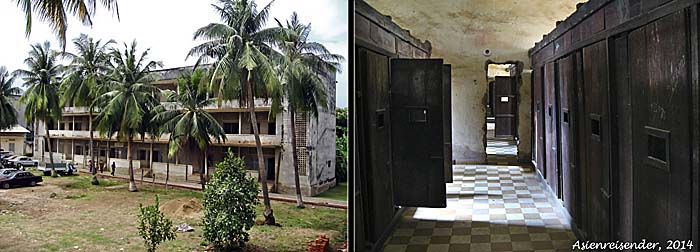
The main building of S-21 (left) and one of the side buildings from inside, from where the photo left was shot. Long walkways with wooden cells for the prisoners. Images and photocomposition by Asienreisender, 2007, 2014
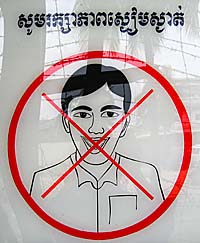
Some people need to be explicitely remembered that Tuol Sleng is no fun park. Image by Asienreisender, 2007
In the first time of Tuol Sleng's existence the prisoners were people from all levels of society, particularly such who were in service of the last pre-Khmer Rouge government Lon Nol. Since dictators have no friends and brutal regimes get naturally more and more paranoid, those who run S-21 killed more and more of their own comrades who were seen as traitors. Even the itself intimidated staff got repetedly exchanged by others, itself imprisoned, interrogated and killed. S-21 was a negative factory, where nothing else was produced except death and, remarkably, buerocracy. It's a curious thing about the Khmer Rouge, who were mainly illiterate, primitive and brutal butchers, to document their bad deeds so detailful. Every prisoner was photographed and a file was opened to report the course of the interrogation. There was a special documentation unit accompanying the interrogations in Tuol Sleng.
Skulls in Tuol Sleng
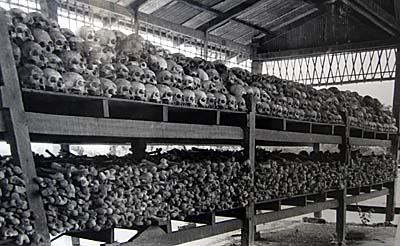
Inside the interrogation center Tuol Sleng (S-21): collected skulls and bones of countless victims. Image by Asienreisender, 2007
When somebody got arrested it was usually so that his whole family was arrested with him too; that was to avoid that family members could take revenge later. A great number of children were among the prisoners. The tortured had to denunciate other people, who were then arrested, tortured and killed as well. There were between 1,000 to 1,500 prisoners at any time in the former school.
Alltogether there were roughly 17,000 people tortured and killed in S-21 respectively at the Killing Fields of Choeung Ek, where those got beaten to death who survived the torture. Among the victims were also a number of foreigners as Vietnamese, Thais and Westerners. More than 1,700 people committed the interrogations and killings. Merely seven prisoners survived S-21 at the end.
The Khmer Rouge were militarily defeated by Vietnamese troops in 1979 (the 3rd Indochina War). Phnom Penh and S-21 was freed from them then. Tuol Sleng / S-21 is now a genocide museum.
Fore a concise introduction into Cambodian History click the link.
The Killing Fields of Choeung Ek
The site of Choeung Ek is one of about 300 rural sites where the Khmer Rouge killed and burried their victims. Choeung Ek is probably the best known of them, for it's just 15km outside of Phnom Penh and served as the execution site for the victims of Tuol Sleng. At Choeung Ek is a stupa placed, which houses a great number (approximately 5,000) of the skulls of the killed people. Many of the skulls show holes, the impact of hacks, axes, iron bars, rifles or whatever the killers used to execute them. Others were stifled with plastic bags, while their hands were bound. Bullets were too scarce and expensive to be used. Since the mass graves weren't very deep and crammed with corpses, bones and skulls are frequently driven to the survace by heavy monsoon rains.
The government of Phnom Penh sold out the site of Choeung Ek to the Japanese company JC Royal. The company pays an annual rent of 15,000 US$ and has therefore the authority to cash an entrance fee of their own decision.
Another one of the killing fields was directly around Wat Nokor in Kampong Cham. Alltogether there were found about 20,000 mass grave sites by a project launched by Yale University. Around 1.4 million people have been executed alltogether at these sites. Additionally to the victims of direct executions many more people (hundreds of thousands more) died due to famine, sicknesses and the lack of medicals and hospitals.
Choeung Ek, Pagoda and Mass Graves
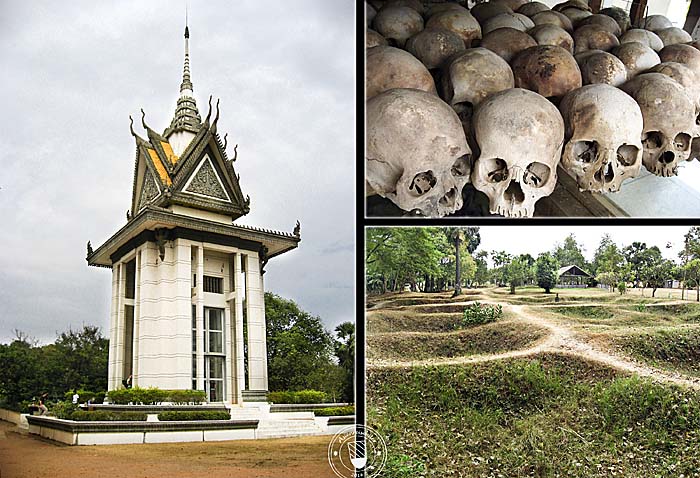
The pagoda with the skulls is placed at the edge of the site. The pits are the mass graves. Images and photocomposition by Asienreisender, 2007, 2014
For the movie 'The Killing Fields' click the link.
